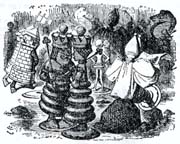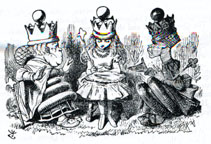Throughout both Into the Looking Glass and Alice and Wonderland, Alice meets a large cast of crazy characters, many of whom boss her around, much to her discontent. However, the most obvious representations of power within the tales are the Kings, and, more importantly, the Queens. All through Alice in Wonderland, Alice hears of the dreaded Queen of Hearts, whose wild temper sends chills down the spines of all her subjects, as evidenced by the gardeners who, "anxiously looking across the garden" (63), attempt to cover up a mistake by painting roses, explaining "we're doing our best, afore she comes..." (63). Fully meeting their expectations, when the Queen arrives and sees their error, she promptly cries, "'Off with their heads!'" (65).
The Queen's random condemnations do not, however, have parallel actions. Indeed, the Queen has little power, in reality, for her orders often go unattended. In one scene in particular, Alice hears "the King say in a low voice, to the company, generally, 'You are all pardoned'" (73), thus completely dismissing the Queen's authority.
In Through the Looking Glass, the royal families consist of the two sides of a game of chess. The Red and the White Queen play roles in this story, encountering Alice on her own journey to attaining a crown. At the very end of the tale, once Alice has become a Queen, she gets the chance to sit down with the other two Queens and talk.


"'Can you do sums?' Alice asked, turning suddenly on the White Queen, for she didn't like being faulted with so much.
"The Queen gasped and shut her eyes. 'I can do Addition,' she said, 'if you give me time - but I can't do Subtraction under any circumstances!'
"'Of course you know your ABC?' said the Red Queen.
"To be sure I do,' said Alice.
"'So do I,' the White Queen whispered: 'we'll often say it over together, dear. And I'll tell you a secret - I can read words of one letter! Isn't that grand? However, don't be discouraged. You'll come to it in time'" [194]
This segment shows that these Queens, much like the Queen of Hearts, fool themselves into ideas of grandeur which simply do not match up with reality. Alice realizes the true silliness of the queens and no longer fears them. Indeed, when she dines with them at a dinner party, she does not hesitate to, frustrated by the strangeness of the customs, upset the entire party. The Queens prove absolutely helpless before Alice, who grabs the Red Queen, "whom she considered as the cause of all the mischief" (204), and "[shakes] her backwards and forwards with all her might" (205). Thus Alice, the child, makes her way through the ranks of power of these imaginary worlds and finds that the mysterious and august appearance of the royalty masks simple, foolish humans, who have no more power or wisdom than anyone else.
Questions
1. How does Carroll show the difference between how the powerful see themselves and how the reader, and eventually Alice as well, sees them?
2. Carroll's stories provide a mix of the utterly random and whimsical with serious commentaries on various aspects of life. To which category do the Queens of his stories belong? Did Carroll intend them to carry some sort of message, or simply to assume the reader?
3. In these stories, Alice at first admires the rich and powerful, wishing to join their ranks, then dismisses them as much less than what they appear. How does this depiction of wealth and status compare to that in Great Expectations? What might this say about Victorian ideas of power? What political movements of the time correspond with these ideas?
4. Throughout these stories, Alice yearns to attain the sort of power she sees in the Queens. Why, when she finally does attain such power, does Carroll opt to have her lose her temper and upset the entire party? Why did he not end with a peaceful dinner party where the guests admired Alice?
Last modified 13 March 2009